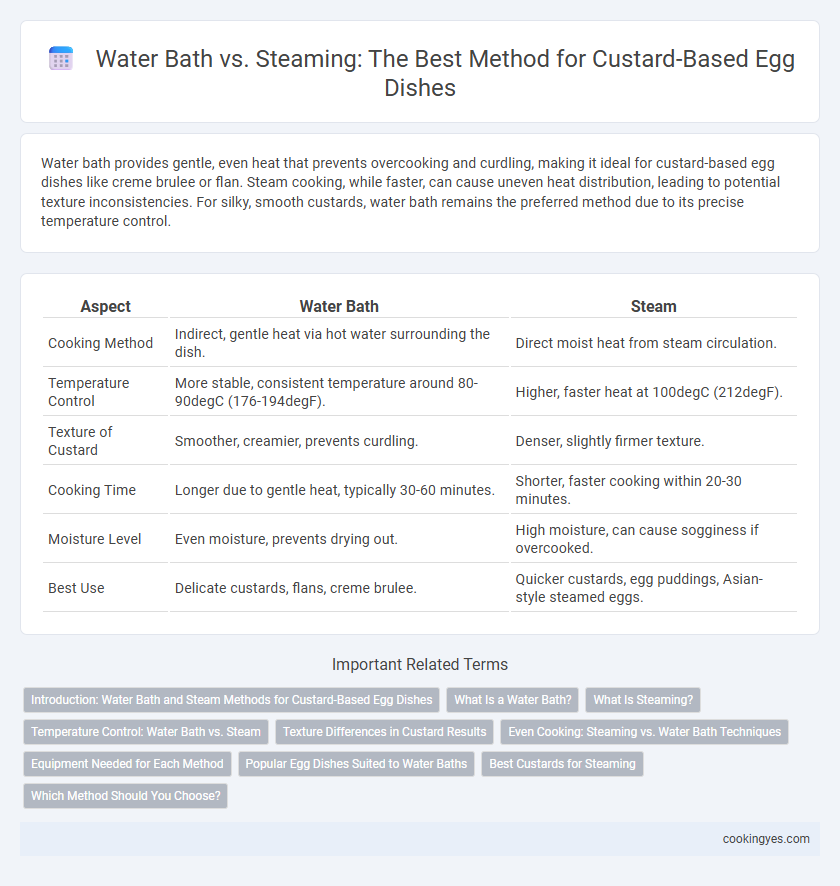Water bath provides gentle, even heat that prevents overcooking and curdling, making it ideal for custard-based egg dishes like creme brulee or flan. Steam cooking, while faster, can cause uneven heat distribution, leading to potential texture inconsistencies. For silky, smooth custards, water bath remains the preferred method due to its precise temperature control.
Table of Comparison
| Aspect | Water Bath | Steam |
|---|---|---|
| Cooking Method | Indirect, gentle heat via hot water surrounding the dish. | Direct moist heat from steam circulation. |
| Temperature Control | More stable, consistent temperature around 80-90degC (176-194degF). | Higher, faster heat at 100degC (212degF). |
| Texture of Custard | Smoother, creamier, prevents curdling. | Denser, slightly firmer texture. |
| Cooking Time | Longer due to gentle heat, typically 30-60 minutes. | Shorter, faster cooking within 20-30 minutes. |
| Moisture Level | Even moisture, prevents drying out. | High moisture, can cause sogginess if overcooked. |
| Best Use | Delicate custards, flans, creme brulee. | Quicker custards, egg puddings, Asian-style steamed eggs. |
Introduction: Water Bath and Steam Methods for Custard-Based Egg Dishes
Water bath cooking for custard-based egg dishes ensures gentle, even heat by surrounding the dish with hot water, preventing curdling and promoting smooth texture. Steam methods cook through moist heat directly from steam, offering faster cooking times but requiring careful temperature control to avoid overcooking. Understanding the differences between water bath and steam is essential for achieving perfect custard consistency in egg dishes.
What Is a Water Bath?
A water bath, or bain-marie, is a cooking technique where a custard-based egg dish is placed in a container of hot water during baking to ensure gentle, even heat distribution. This method prevents direct exposure to high oven temperatures, reducing the risk of curdling or cracking by maintaining consistent moisture and heat around the dish. Unlike steam cooking, a water bath relies on indirect heat from the surrounding water, promoting a smooth, creamy texture essential for delicate custards like creme brulee and flan.
What Is Steaming?
Steaming is a cooking method that uses hot steam to gently cook custard-based egg dishes, preserving moisture and creating a smooth texture. Unlike water baths that surround the dish with hot water, steaming suspends the container above boiling water, ensuring even heat distribution without direct contact with liquid. This method minimizes the risk of curdling or overcooking, resulting in a delicate and tender custard.
Temperature Control: Water Bath vs. Steam
Water bath provides gentle, even heat by surrounding custard-based egg dishes with hot water, maintaining a stable temperature around 80-85degC, which prevents curdling and ensures smooth texture. Steam cooking offers rapid heat transfer and typically holds a consistent temperature near 100degC, reducing cooking time but increasing the risk of overcooking or water condensation affecting the custard's consistency. Precise temperature control in water baths minimizes temperature fluctuations, while steam requires careful monitoring to avoid overheating and preserve the delicate structure of egg custards.
Texture Differences in Custard Results
Water bath cooking for custard-based egg dishes ensures gentle, even heat distribution, resulting in a smooth, creamy texture without curdling. Steam cooking produces a slightly denser custard with a more delicate, tender surface due to direct moisture contact. Choosing between water bath and steam significantly influences the custard's final texture, with water bath favored for silky consistency and steam for a softer, more custardy finish.
Even Cooking: Steaming vs. Water Bath Techniques
Steaming provides more direct and consistent heat, resulting in evenly cooked custard with a smooth texture. Water baths offer gentle, indirect heat by surrounding the custard with warm water, minimizing temperature fluctuations and preventing curdling. Both methods promote even cooking, but steaming is faster while water baths excel in subtle temperature control for delicate egg custards.
Equipment Needed for Each Method
Water bath custard requires a deep roasting pan filled with hot water to evenly distribute heat and prevent curdling, along with oven-safe ramekins or baking dishes. Steam cooking demands a steamer or an appliance with a steam function, such as an electric steamer or a stovetop steamer basket that allows gentle, moist heat to set the custard. Both methods benefit from precise temperature control tools like a kitchen thermometer to ensure perfect texture in egg custards.
Popular Egg Dishes Suited to Water Baths
Water baths are ideal for delicate custard-based egg dishes like creme brulee, flan, and quiches, ensuring even heat distribution to prevent curdling. Steam, while faster, can cause uneven cooking and a less creamy texture in these sensitive recipes. Egg custards benefit from the gentle, consistent moisture of water baths to achieve a smooth, silky finish.
Best Custards for Steaming
Steaming produces the best custards for egg dishes by providing gentle, even heat that prevents curdling and ensures a silky texture. Water bath methods can introduce excess moisture, sometimes resulting in a less smooth, slightly denser custard. Optimal steamed egg custards showcase a delicate consistency and enhanced creaminess due to precise temperature control.
Which Method Should You Choose?
For custard-based egg dishes, a water bath provides gentle, even heat that minimizes the risk of curdling and ensures a smooth, creamy texture. Steam cooking offers faster heat transfer but can create uneven cooking and a less delicate consistency. Choose a water bath for delicate custards like creme brulee, while steam is better suited for firmer dishes like savory egg custards.
Water bath vs Steam for custard-based egg dishes Infographic

 cookingyes.com
cookingyes.com